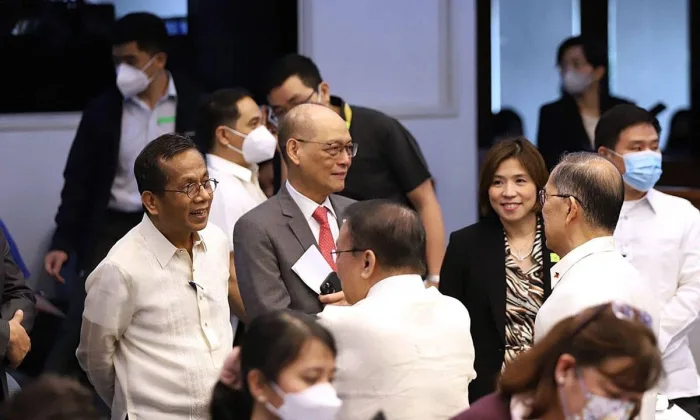
BETTER late than never! At long last, despite some opposition and resistance from several nongovernmental organizations, primarily agriculture-based groups which have been asking members of the Senate to abandon the trade pact, the Regional Comprehensive Economic Partnership (RCEP) was ratified by the Senate last Feb. 21, 2023 after two days of plenary debates. It will be recalled that former president Rodrigo Duterte signed the RCEP, but for it to be fully effective, it needs the concurrence of the Senate. Thus far, 20 senators have voted in favor of RCEP, one abstained and one voted against.
RCEP in a nutshell
The RCEP is thus far the biggest trade deal in history and globally. It is a genuine trade deal for Asia in Asia. It is an essential agreement for the Philippines and the Asia-Pacific region. It brought all 15 countries, Asean (Association of Southeast Asian Nations) member states and their major trading partners — Australia, China, Japan, New Zealand and South Korea — together in simplified trade processes and arrangements for the first time.
Geopolitically speaking, RCEP is a win-through of Asean centrality because Asean was in the midst of the RCEP’s negotiation process. Thus, RCEP is a showcase of the middle-power diplomacy of Asean, which also means that Asean member states like the Philippines are vital players in setting the terms of engagement, and rules played and to be played by RCEP.
RCEP provides a framework for regional economic and trade cooperation in the broader Asia-Pacific region. It integrates and optimizes the region’s economic and trade rules in a wide range of fields, including goods, services, investment, intellectual property rights, e-commerce and competition policy, which further promote the integrated development of the industrial chain, supply chain and value chain in the region. Besides its size, RCEP reinforces regional supply chain integration by liberalizing rules of origin. It allows traders, particularly from the Philippines, to source intermediate goods from any of the 15 members with only one certification of origin, further enhancing East Asia’s regional economic integration and significantly improving the overall business environment in the region. In retrospect, an integrated hyper-sized market has been born out of RCEP, injecting a strong impetus into regional and global economic growth.
Thank goodness the Philippines is now officially part of RCEP. This is indeed a much-awaited and welcome positive development. RCEP ratification is a triumph over protectionism or protectionist policies. The Philippines is to benefit from RCEP, given that it is now an official and full-fledged member of the trade pact.
RCEP’s benefits
Insofar as the agricultural sector of the Philippines is concerned, under the RCEP framework, it has been pointed out by the Department of Trade and Industry (DTI), at least during the previous administration, that the agricultural sector is safe with RCEP precisely because no new highly sensitive agricultural products were included from the country’s schedule of commitments.
These highly sensitive agricultural products include swine, poultry, potatoes, onions, garlic, cabbage, sugar, carrots and rice. A tariff, a tax imposed by the Philippine government on imports or exports of these sensitive farm products, is still in effect even now that the country has become a full member of RCEP. This means that tariffs still protect these sensitive agricultural products. Likewise, there are safety nets in place to counter any risks and protect the Philippines’ economy and the public from any unforeseen circumstances, and these include: a) a grace period/flexibility to implement new commitments; b) trade remedies; c) modifications of commitments in exceptional circumstance; d) investment reservations; and e) exceptions.
Generally speaking, the Philippines’ membership in RCEP will provide the agricultural sector with the broadest possible and wide-ranging opportunities to enhance the country’s market access, trade facilitation measures, time-bound consultation in addressing trade issues, more investments in research and development (R&D) in the agricultural sciences, and even manufacturing.
Filipino farmers and producers will have the opportunity to gain access to steady, secure and cheaper farm inputs, and instruments like fertilizers, pesticides and farm machinery. Take note that more than 70 percent of the country’s imports of fertilizers is from RCEP member states like China, Indonesia, Malaysia, South Korea, Vietnam and Japan, in the same manner that around 70 percent of the importation of insecticides is also from RCEP countries like China, Malaysia, Indonesia, Japan and South Korea. Also, when importing agricultural machinery, more than 70 percent are from RCEP countries like China, Thailand and Japan. In many ways, all these make the country’s entry into RCEP vital, and will most definitely yield benefits for the Philippines.
More importantly, under the RCEP mechanisms and framework, Filipino farmers can also export their products to RCEP’s more extensive and broader market at a preferential and more trade facilitative arrangement. Through RCEP, Filipino farmers will also have access to investments in food processing, and R&D in agricultural sciences and technology.
No doubt, the country’s agricultural sector will most definitely benefit from RCEP while at the same time enjoying tariff protection of the country’s sensitive agricultural products. With this, the Philippines will enjoy the best of both worlds.
More benefits
Furthermore, RCEP is also expected to bring tangible new opportunities to the business community in the Philippines, especially in creating favorable conditions for the micro, small and medium enterprises (MSMEs), which are the backbone of the Philippine economy, so that they could better participate in regional economic and trade cooperation, and tap into the markets of RCEP member states while enjoying the policy dividends of this agreement.
RCEP plays a critical role in boosting equitable economic growth, especially for MSMEs, through the expansion of regional trade, services and investment linkages. Through RCEP, the Philippines will enjoy and benefit from having access to: a) cheaper costs for sourcing key inputs of the manufacturing sector; b) convenience for businesses in trading with key free trade agreement partners; c) competitiveness for Philippine industries; and d) complementation of existing government support programs.
Also, the Philippines will enjoy and benefit from the noteworthy advantageous features of being part of RCEP, which include: 1) simplified and unified rules; 2) fewer barriers; 3) advanced custom procedures; 4) less administrative cost and trade facilitative; 5) enhanced market access; 6) adopt rules and disciplines on e-commerce; 7) stronger intellectual property rights (IPR) protection; and 8) implementation of competition policies.
Likewise, RCEP will help and encourage the inflow of foreign investments into the country, facilitate an opportunity to partner and form joint ventures within the region, and allow greater participation of more service providers in vital sectors such as manufacturing, creative sectors, financial services, aerospace and shipbuilding, R&D, IT-BPO (information technology-business process outsourcing), professional services, education services, and energy, among others.
Most importantly, RCEP will provide Philippine exporters with sources from 14 countries, including the country’s top import source of raw materials, China and Asean. RCEP will also allow Philippine traders to source intermediate goods from any of the 14 RCEP member countries with only one certification of origin and will significantly improve the overall business environment of the Philippines.
Conclusion
No doubt, as a full-fledged member of RCEP now, the Philippines will benefit much from the trade agreement both in the short and long term, more particularly when it comes to access to trade and investment opportunities. This is a wise, commendable and advantageous move for the Philippine government and the Senate. It is indeed most exciting to see how the Philippines will maximize the opportunities and potentials of RCEP to its advantage toward economic progress and development. We will see!
Source: The Manila Times
https://www.manilatimes.net/2023/02/23/opinion/columns/senate-rcep-ratification-a-wise-move/1879899
